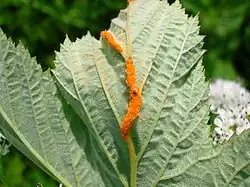Triphragmium ulmariae
| Triphragmium ulmariae | |
|---|---|

| |
| Mature gall on a leaf of meadowsweet (Filipendula ulmaria) | |
| Scientific classification | |
| Kingdom: | Fungi |
| Division: | Basidiomycota |
| Class: | Pucciniomycetes |
| Order: | Pucciniales |
| Family: | Sphaerophragmiaceae |
| Genus: | Triphragmium |
| Species: | T. ulmariae
|
| Binomial name | |
| Triphragmium ulmariae (DC.) Link
| |
| Synonyms[1] | |
|
Puccinia ulmariae DC. (1808) | |
Triphragmium ulmariae is a species of rust fungus in the family Sphaerophragmiaceae. It causes meadowsweet rust gall,[2] which develops as a chemically induced swelling, arising from the lower surface of the meadowsweet (Filipendula ulmaria) leaves.[3]
Life cycle
The fungus grows in the petioles and midribs of the perennial plant meadowsweet (Filipendula ulmaria), a member of the rose family, causing swelling and distortion. Sori develop with bright orange spores.[3] The rust's spores reach the new meadowsweet plants via air movements.
The rust has a severe effect on the survival of meadowsweet seedlings.
References
- ^ "Triphragmium ulmariae (DC.) Link 1825". MycoBank. International Mycological Association. Retrieved 2011-07-08.
- ^ Biolimages Archived 2008-08-21 at the Wayback Machine
- ^ a b Stubbs, F. B. Edit. (1986) Provisional Keys to British Plant Galls. Pub. Brit Plant Gall Soc. ISBN 0-9511582-0-1. P. 27.